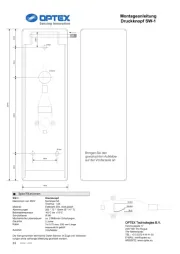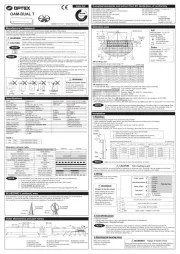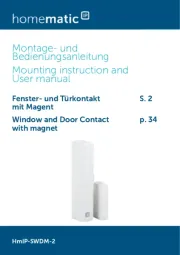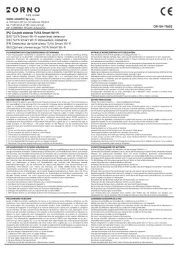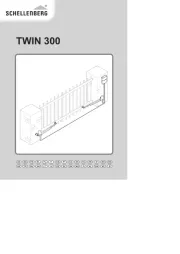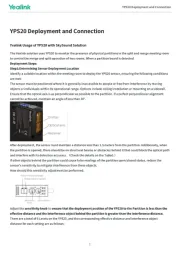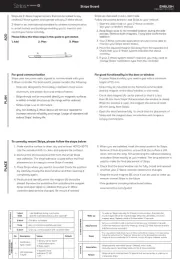(1) Connector
(2) Mounting holes
(3) Operation indicator
(4) Function switch
(5) Dipswitches
(6) Area angle adjustment screws
(7) Area width adjustment screws
(8) Detection window
(9) Area adjustment tool
[mm (inch)]
*1 : BLUEZONE (Lookback), 2nd and 3rd rows have a presence detection function.
*2 :
When using this sensor, the sensor has to be connected to a door system which has the SELV circuit.
*3 : Overcurrent protection with less than 2A.
*4 : See BLUEZONE (Lookback) area
*5 : LED will be turned off approx. 500 ms when the sensor Test output signal works well.
Charts show the values in the following area angle adjustment settings
Test conditions required by EN 16005
Floor : Grey paper
Detection object : EN 16005 CA reference body
Sensitivity : High
Speed of detection object : 50 mm/s
The values above are those of the when tested referring to the test conditions of EN 16005. Detection area
(The emitting area is as shown in above.) Emitting area
Knockout
0.07 (3")
0.06 (2")
0.07 (3")
0.06 (2")
0.14 (6") 0.14 (6") 0.14 (6")
NI-0169-1Original instructions
OA-FLEX T
ENGLISH
5929990 JAN 2021
Manufacturer's statement
Read this operation manual carefully before use to ensure proper operation of this product.
Failure to read this operation manual may cause improper operation and may result in serious injury or death of a person.
The meanings of the symbols are as follows.
1. This product is a non-contact switch intended for header mount or wall mount for use on an automatic
sliding door. Do not use for any other applications.
2. When setting the sensor's detection area, make sure that there is no traffic around the installation site.
3. Before turning the power ON, check the wiring to prevent damage or malfunction of equipment
connected to the product.
4. Only use the product as specified in the operation manual provided.
5. Be sure to install and adjust the sensor in accordance with the local laws and standards of the country
in which the product is installed.
6. Before leaving the installation site make sure that the product is operating properly and instruct the
building owner/operator on proper operation of the door and the product.
7. The product settings can only be changed by an installer or service engineer.
When changed, the changed settings and the date shall be registered in the maintenance logbook
accompanying the door.
It is required to check the operation manual if this symbol is shown on the product.
Failure to follow the instructions that accompany this indication and improper handling
may result in serious injury or death.
WARNING
Failure to follow the instructions that accompany this indication and improper handling
may result in injury and/or damage to property.
CAUTION
Pay special attention to sections with this symbol.
NOTE
NOTE
Do not wash, disassemble,
rebuild or repair the sensor,
otherwise it may cause electric
shock or breakdown of the
equipment.
Danger of electric shock
WARNING
The following conditions are not suitable for sensor installation.
Fog,
Exhaust Wet Vibration Objects Reflection
Specifications
Model
Cover color
Mounting height
Detection area
Detection method
Area angle adjustment
Power supply (*2)
Power consumption
Operation indicator
Output hold time
Response time
Operating temperature
Operating humidity
Noise level
: OA-FLEX T
: Silver/Black
: 2.0 to 3.0 m (6'7" to 9'10")
(2.0m(6'7") to 2.5m (8'2") for
EN16005 compliance)
: See Detection area
: Active infrared reflection (*1)
: Depth : -8° to +8°
Width : ±7°
: 12 to 24 VAC ±10 % (50/60 Hz)
12 to 30 VDC ±10 %
: < 2.0 W (< 5 VA at AC)
: See Operation indicator table
: < 500 ms
: < 300 ms
: -20 to +55°C (-4 to 131°F)
: < 80 %(non-condensing)
: < 70 dBA
Activation output
Safety output
Test input
IP rate
Category
Performance level
ESPE
Weight
Accessories
: Form A relay 50 V 0.3 A Max.
(Resistance load)
: Form A relay 50 V 0.3 A Max.
: Opto coupler
Voltage 5 to 30 VDC
Current 6 mA Max. (30 VDC)
: IP54
: 2 (EN ISO 13849-1:2015)
: d (EN ISO 13849-1:2015)
: Type 2
: 220 g (7.8 oz)
: 1 Operation manual
2 Mounting screws
1 Mounting template
1 Area adjustment tool
1 Cable 3 m (9'10")(*3)
1000 ms 1000 ms
Setting error
Signal saturation
Sensitivity too low(or Sensor failure)
Red & Green blinking
Slow Green blinking
Fast Green blinking
Operation indicator table
Warm-up
Stand-by (Installation mode)
Stand-by (Service mode)
Status
Yellow blinking
Yellow
Operation indicator color
Stand-by (Operation mode)
2nd row detection
BLUEZONE (Lookback) detection (*4)
3rd row detection
4th - 6th row detection
Green
Orange
Red
Red blinking
Blue
Yellow & Green blinking
Communication Test output Turn off 500 ms (*5)
The specifications herein are subject to change without prior notice due to improvements.
NOTE
When dipswitch 15 is set to
"
ON
"
, the BLUEZONE (Lookback) area, that provides extra safety over the threshold is
activated. In case the BLUEZONE (Lookback) function is not required, set dipswitch 15 to
"
OFF
"
.
Do not set the 2nd row overlapping the threshold regardless of the setting of dipswitch 15.
BLUEZONE (Lookback) area
BLUEZONE
(Lookback)
2nd row
3rd row
6th row
5th row
4th row
2nd row overlapping
the threshold
BLUEZONE
(Lookback)
2nd row
3rd row
5th row
4th row
6th row
245(9 5/8") 37(1 7/16")
7.5(5/16")
68(2 11/16")
36(1 7/16") 43(1 11/16")
125(4 15/16")
(1) (2)
(3) (7)(6)(5) (8)
(9)
(4)
Outer dimensions and part names
Complied standards and extract from EC declaration of conformity
For technical document, see European Subsidiary
Notified Body 0044 : TÜV NORD CERT GmbH Langemarckstr. 20 45141 Essen Germany
EN 16005:2012/AC:2015 Chapter 4.6.8 and Annex C
EN 61496-3:2001 clause 4. 3. 5 and 5. 4. 7. 3
EN 61000-6-3:2007 +A1:2011/AC:2012
A. Maekawa
General Manager
OPTEX CO., LTD.
Quality Control Dept.
DIN 18650-1:2010 Chapter 5.7.4 ESPE
Machinery Directive 2006/42/EC
EN 12978:2003 +A1:2009
EMC Directive 2014/30/EU
EN ISO 13849-1:2015
EN ISO 13849-2:2012
EN 61000-6-2:2005/AC:2005
: Emitting spots
: Detection area
: Emitting spots
(can be eliminated)
Detection area
To comply with EN 16005, make sure that the detection area is
within the values of the chart below.
Detection area
The actual detection area may become smaller depending on the ambient light, the color/material of the
object or the floor as well as the entry speed of the object. The sensor may not be activated when the
entering speed of the object or a person is slower than 50 mm/s or faster than 1500 mm/s.
NOTE
BCDEFG
H
I
J
BLUEZONE
(Lookback)
2nd row
3rd row
4th row
5th row
6th row
A
X
Depth
Width
: 8°
: 0°
B
C
D
E
F
G
H
I
J
A
[m(feet,inch)]
2.00 (6'7") 2.30 (7'7") 2.50 (8'2")
0.38 (1'3") 0.46 (1'6") 0.50 (1'8")
2.06 (6'9") 2.48 (8'2") 2.69 (8'10")
1.49 (4 ") 1.80 (5 ") 1.95 (6'5")'11 '11
0.92 (3') 1.11 (3'8") 1.20 (3' ")11
1.75 (5'9") 2.11 (6' ") 2.29 (7'6")11
1.34 (4'5") 1.62 (5'4") 1.76 (5'9")
0.84 (2'9") 1.01 (3'4") 1.09 (3'7")
0.71 (2'4") 0.86 (2'10") 0.94 (3'1")
0.13 (5") 0.16 (6") 0.17 (7")
Emitting area
X
H
J
0.24 (9")
0.85 (2'9")
2.01 (6'7")
0.25 (10")
0.91 (2'12")
2.20 (7'3")
0.23 (9")
0.96 (3'2")
2.44 (8')
A
[m(feet,inch)]
2.00 (6'7") 2.30 (7'7") 2.50 (8'2")
Installation
X
H
Y
Sensor
Door
Header
Floor
a. Place the mounting template at the desired mounting position.
(When setting the detection area close to the door, mount the sensor according to the chart below.)
b. Drill two mounting holes of ø3.4 mm (ø1/8").
c. To pass the cable through the header, drill a wiring hole of ø8 mm (ø5/16").
d. Remove the mounting template.
e. Remove the housing cover. Fix the sensor to the mounting surface with the two mounting screws.
Make sure not to mount the sensor lower than the bottom of header.
1. Mounting
H : Height from the floor to the bottom of the header
(The mounting height is " + ".)H Y
Y : Distance between the bottom of the header and the sensor
X : Distance between the door and the mounting surface
NOTE
CAUTION Risk of getting caught
Make sure to affix the mounting template as described in the above chart, otherwise it can be dangerous since there
may be no detection area around the threshold. Install the sensor as low as possible on the header.
12 to 24 VAC ±10 % / 12 to 30 VDC ±10 %
Form A relay 50 V 0.3 A Max.
Opto coupler / Voltage: 5 to 30 VDC
Form A relay 50 V 0.3 A Max.
Maximum mounting distance ( )Y
X2.00 (6'7")
0
0.05 (2")
0.10 (4") 0.11 (4") 0.11 (4")
0.15 (6") 0.10 (4")
0.20 (8")
0.25 (10")
0.30 (12")
H
0.13 (5")
2.50 (8'2")
0.13 (5")
0.10 (4")
0.09 (4")
[m (feet,inch)]
2.30 (7'7")
0.13 (5")
0.11 (4")
0.10 (4")
0.09 (4")
0.07 (3")
0.06 (2")
0.09 (4")
Do not use the sensor without the cover. When using the cable knockout,
install the sensor indoors or use the rain cover (Separately available)
otherwise electric shock or breakdown of the sensor may occur.
WARNING Danger of electric shock
Make sure to connect the cable correctly to the door controller before turning the power ON.
When turning the power ON or after adjusting the settings, do not enter the detection area for more
than 10 s in order to enable the presence detection. Do not touch the dipswitches before turning the
power ON, otherwise an error occurs. After changing the dipswitch settings, make sure to push the
function switch for 2 s.
a. Plug the connector.
b. Supply power to the sensor. Adjust the detection area and set the dipswitches.
(See )Adjustments 3. Dipswitch settings
3. Turn ON the power
NOTE
Place the housing cover. If wiring is to be exposed, break the knockout.
4. Mounting the housing cover
1.White
2.Brown
3.Green
4.Yellow
5.Pink
6.Blue
7.Red
8.Black
9. Grey/Pink
10. Red/Blue
Power supply
Safety output
Activation output 2
1
3
4Test input **
Not used *
Polarity free
2. Wiring
Wire the cable to the door controller.
* The following 2 cables are not used.
Grey/Pink
Red/Blue
** See DIP 8(Test input) comment
in " ".3. Dipswitch settings
Web manual
1
3
4
2
Before starting the procedure, make
sure that the power is turned OFF.
When passing the cable through the
hole, do not tear the shield otherwise
it may cause electric shock or
breakdown of the sensor.
Danger of electric shock
WARNING
